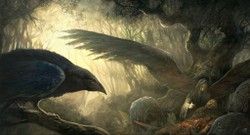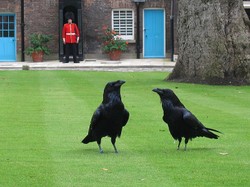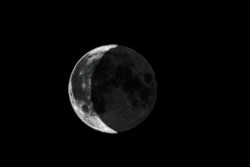Encountering the Morrigan wasn't necessarily a bad thing, even in the most arduous of ancient Irish legends. She produced challenges, wherein the rewards for overcoming them were immense. Most often, She sought to highlight a flaw in the system or a weakness in the defenses, which - once fixed - strengthened everything.
But when the raven turned up, then Morrigan wasn't playing anymore. The raven meant death.
In the instant before Cú Chulainn saw the raven, he had been rejecting the advances of a beautiful woman. He did so because he was in the midst of a series of single combat fights, forced into the situation by the curse of Macha of the Swift Heels.
Hence he'd already missed the fact that Badb and Macha had taken an interest. He would not miss Nemain. Sex and violence were par for the course for a young Irish warrior. The raven meant that Nemain had him in Her sights. He could not survive that.
Skip forward through several colorful events, and we arrive at a battlefield. Cú Chulainn is already weakened, as Macha (aka Mebh) has tricked him into eating food which is against his personal gaes (taboo). (Modern audiences might imagine it as Superman attempting to fight under the influence of kryptonite.) He was also thoroughly spooked on the way there, as he witnessed Badb washing his clothes in a river.
Cú Chulainn received three fatal wounds that day, but tied himself to a standing stone with his sword arm fastened above his head. His battle prowess was so legendary and feared that none dared to approach, until they could be certain that he was truly dead. But who could tell without drawing close enough to be slain?
It was a scene reminiscent of the moment when the Morrigan had initially turned against him. Cú Chulainn stood alone against a distant army. Once again, Nemain took the form of a raven. She flew onto his shoulder and pecked at his face.
In that undeniable form, Nemain had declared this story over, and the victors came to hack Cú Chulainn's body to shreds.



















 St Tydecho's Churches in West Waleson 09/03/2014
St Tydecho's Churches in West Waleson 09/03/2014
 Goodies for an Outlander Premiere Partyon 03/06/2015
Goodies for an Outlander Premiere Partyon 03/06/2015
 Holocaust Memorial Day Interview with Rainer Höss, Grandson of Rudolf Architect of Auschwitzon 01/24/2015
Holocaust Memorial Day Interview with Rainer Höss, Grandson of Rudolf Architect of Auschwitzon 01/24/2015
 Romantic Valentine Gifts for an Outlander Fanon 01/16/2015
Romantic Valentine Gifts for an Outlander Fanon 01/16/2015



Comments
Wow! Really? That's truly amazing! Thank you very much. <3
Good morning nice lady! Shared this to my Pinterest board and just wanted you to know it has been repinned 200+ times.
This is true! But in fairness so am I, and they're still bigger than me!
They are well fed.
Aww! Thank you very much. :)
I like ravens too, though the ones in the Tower of London are surprisingly huge!
Yeah. What you and Frank already said. :)
Only thing I have to add is I like ravens - whether optimistic and free-spirited, or dark and moody. Especially the character Raven from the animated TV series Teen Titans. She reminds me of my daughter. "I don't do happy." :)
Sharing this via my Mythology board on Pinterest. :)
- http://www.pinterest.com/cmoneyspinne...
It was said previously that, as long as Bran's head is under Tower Hill, Britain will never be invaded. Mmmmm....
Incidentally, Bran means 'raven'. :) Thanks for this.
We keep ravens in the Tower of London because, it is believed they are sacred to the Celtic god, Bran. The site on which the Tower is set was once, it is thought, sacred to Bran, hence their presence was to keep him happy. Hence the legend that when the ravens depart, the British monarchy will end. That's why they keep the ravens well fed and their numbers are always maintained.